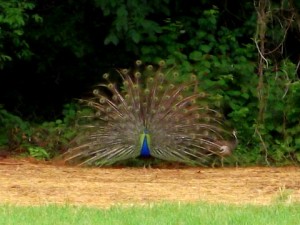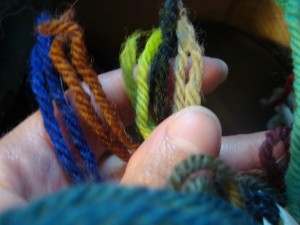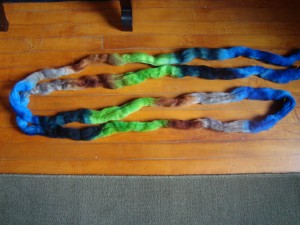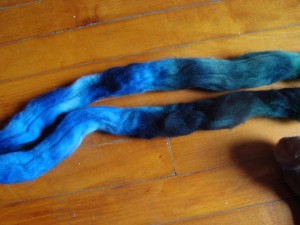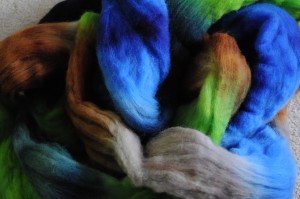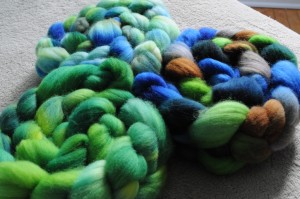Mon 22 Aug 2011
The moment has now arrived – I can tell you what I’ve been up to. (I’ve gotten confirmation that the surprise has been had, and it is now safe to post all the fun details.)
This is the third fiber in the latest series of dyeing posts. (Look back at the colors; you’ll see that they really are almost the same. Amazing how much variety you get just by applying the colors differently.) I thought that I’d share a little bit about the process of dyeing this one, to make up for the whispers and the suspense.
I got word a couple of weeks ago that Jan had fallen prey to the spinning bug at Sock Summit. And there is nothing like a little good fiber to start a spinner on her way, now is there? So I did a little research, and I enlisted an accomplice. (Sisters are a wonderful thing, especially when they know addresses for mailing things on the sly.)
After poking around on the Twinset blog for a while, I found this photo of a peacock that frequents Jan’s beautiful new house. Look at those colors!
As soon as I found it, I knew that this had to be the color. Now, it was just a matter of translating it into fiber. The blue and the dark spruce green were obvious; they’re what I think of as traditional peacock colors. The gray in his wings was unexpected, though.
And when he opens his tail, the browns and the lime green pop out.
When I look at a photo, I look first for the dominant colors. Then I look for the unexpected ones (like that fabulous bright green). In this case, the dominant hues were strong, vibrant colors. I wanted something to ground them and balance their intensity. The gray and the brown came in here; subtle background colors to help show off the rest.
Next, I went to my sample cards, and plucked out colors that came close.
Next, I needed to decide how to lay them on the fiber. I wanted long repeats of the same color, so that they really stand out from one another. That meant that the dye needed to cover more than a staple length (and sometimes two or three, to make the long repeats really long). The proportion of fiber dyed in each color would determine  the weight of each color in the final yarn. Blue, of course, is dominant. Then the greens, and the brown and gray to balance them out.
I divided the fiber up into sections, and then decided which colors would blend the best at the joins between color repeats. I didn’t want the colors to blend too abruptly, so I chose to paint in order; dark blue to dark green. Light green to brown, brown to gray. Subtle changes that should help to keep the colors intact.
Unfortunately, I neglected to take a picture of that step in the process (I was too excited about how it was coming out).
Here’s a picture of the final fiber, instead.
Within each section, I started with my base dilution, and then added in splashes of more concentrated dye to keep the colors dynamic. See all those different shades?
I must say that I am thoroughly pleased with the results. Proud as a peacock, perhaps.
Because I loved these colors so much, I dyed another 4 oz, same as the first.
Now that the first has safely arrived, the second has gone to join its siblings on Etsy.
Don’t they look beautiful together? (It’s like the litters of kittens we used to foster; I know it’s time and it’s for the best, but I hate to split them up!)
Up next, we’ll be taking the dyeing in a whole new color direction: Linda has gotten my brain churning with visions of pansy purple.

